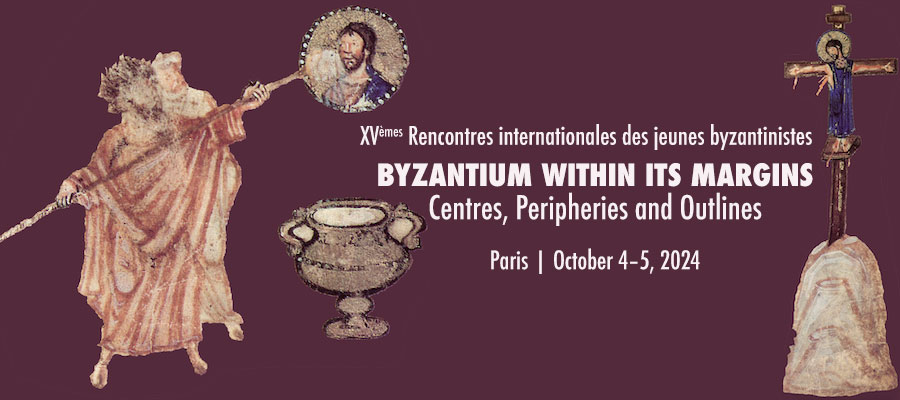Byzantium within Its Margins: Centres, Peripheries and Outlines, XVèmes Rencontres internationales des jeunes byzantinistes, Paris, October 4–5, 2024
A mountain, a cross, an executioner: everything in the well-known miniature of the Chludov Psalter carries us “outside”. At the gates of the city and on the margins of society, the Crucifixion also recalls, through the memory of Iconoclasm, the shifting outlines of Christian dogma. From the margin where it is seemingly relegated, the image overlooks the text to better mitigate its authority. Yet, in this remarkable mise en abyme, a sense of confusion remains: which of the written word or the image holds centre stage – if there is any?
There is but one step from the margins of the psalter to those of Byzantium. As a quintessential microcosm, the illuminated manuscript invites us to extend this ambivalent notion to the scale of a world. Like the shifting lines of a border, the tension emerging between the text and the miniature likewise surfaces in varied ways across the map: between the capital and its provinces, the Empire and its vassals, the Christian prince and his neighbours.
Thus, some borderlands emerge over time as centres of power in their own right – Serbia and Bulgaria, Epirus and Trebizond – occasionally turning Byzantium itself into a margin. Others, further removed from Constantinople geographically, culturally or spiritually – nevertheless maintain subtle ties with it to better define their own identity, such as Armenia, Sicily, Rus’ and even Ethiopia – all in a way Byzantium(s) beyond Byzantium.
By scaling down the territorial questions of the Empire to urban space, or transposing them onto the space of the church, the same paradigm invites us to retrace their axes and thresholds. City walls and structures, church architecture and decoration, pilgrimage sites and necropoleis constantly reshape and redefine the notion of liminality.
Both the Torture of Christ and the sacrilege of iconoclasm suggest a social norm: heresy, like Calvary, excludes, cuts off and marginalises. Yet the fringes of Byzantine society, which go far beyond contemporary projections, compose a nuanced mosaic whose many elements, often overshadowed – women, criminals, ascetics –, call upon us to rethink the cohesion of the whole.
Monks and monasteries proclaim their marginal status as much as they idealise it: both their location, on the fringes if not within the heart of the city, as well as the social recognition they receive seemingly contradict the reclusion they claim to seek. Exile itself, though bitter, keeps its object surely within the line of sight: the exile is watched when far away, writes back and sometimes returns.
To consider Byzantium, lastly, requires the distant and decentred gaze of foreign eyes. Armenian, Latin and Syriac chroniclers, Arab and Mongol emissaries turned a careful, sometimes cruel eye on the Empire, its culture and rites, which historians would be wrong to ignore. The discipline of Byzantine history itself has long been relegated to the margins of the field, as a necessary but uninteresting transition, with Byzantium variously held as the last jolt of the Greco Roman world, the exhaustingly long final breath of the Late Roman Empire or the prelude to Ottoman Turkey.
Centres, norms, limits: everything remained to be done for the partisans of an autonomous study of Byzantine culture. Today, the delicate tension between the centre of the world and the margins of the Empire reflects both the advances and the pitfalls faced by academic inquiry. Such are the aims of the XVth Rencontres : to consider Byzantium within its margins, from its margins and as a margin.
Papers may concern the following themes:
- Territorial margins, borders and spaces of transition
- Settlement of margins and population transfers
- The situation of women, children and slaves
- Definitions and transgressions of gender norms
- Disease, disability, infirmity and death
- Religious controversies, heresy, excommunication and anathema
- Monastic communities
- Visible forms of marginality such as dress and foodways
- Byzantium as a margin
Papers, with an expected duration of 20 minutes, may be presented in French or English.
